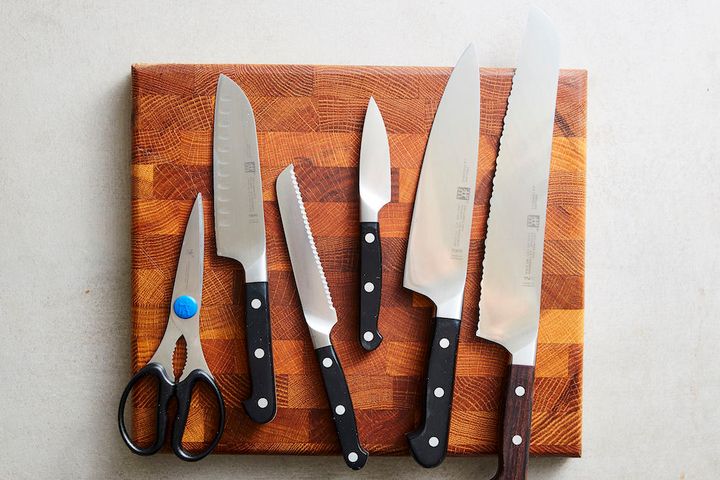
Whether you’re a world-class chef, a novice in the kitchen, or somewhere in between, it’s always helpful to have the right tools to create your culinary concoctions. While pots and pans are seriously important (step away from the microwave!), good knives are essential to become the chef you’re destined to be. However, when you see a knife block, we know it’s hard to know which one to choose: “Do I slice and dice my onions with a big blade or stick to a small one?” “What exactly is a chef’s knife?” “Santoku? What’s that?” Rest assured, Plated has you covered with a foolproof guide to kitchen knives and when to use each one. And, as a lasting piece of advice, always hand wash your blades!

You’ve probably seen a bread knife many times. It features a long, rectangular blade that is serrated with small grooves at the bottom. While you may not use the bread knife as frequently as others, when you need to slice a baguette, there’s no other knife that will do the trick. The longer blade makes it easy to slice through large loaves of bread, and the serration is essential for actually cutting through the crust in a saw-like manner without crushing the airy bread itself. Serrated bread knives are also a wonderful tool for tomatoes. Unlike other knives that aren’t able to penetrate the skin and even smash the flesh in the process, the serrated blade manages to slice directly through the skin. Bread knives also work well on other thin-skinned fruits like nectarines and peaches.
As you might have guessed, the santoku knife has its roots in Japan, a country known for its impeccable blade craftsmanship (think: swords). “Santoku” means “three virtues,” which is a fitting name for this super versatile knife. Unlike the others, santokus have a round, cleaver-like tip at the end and a “granton edge” (small dimples on the edge of the blade, which help prevent ingredients sticking to the knife). Like a chef’s knife, the santoku can be used for any number of kitchen tasks. Santoku knives generally remain sharp for a long time on their own, but if you do decide to sharpen it, you’re best off getting it professionally done.

When you think of a cooking knife, you’ve probably got a chef’s knife in mind. This versatile blade, ideally 8 to 9 inches in length, is the ultimate everyday knife: indispensable in the kitchen and used for slicing, dicing, chopping, and mincing. There are myriad versions of the chef’s knife, but the biggest thing to note is that this one should be sharpened frequently!
You may have encountered these in horror movies or butcher shops, but if you’re serious about breaking down hunks of meat, a cleaver (also known as a butcher’s knife) is an essential tool. It has a rectangular, heavy blade that breaks through or “cleaves” meat and bone without breakage to the knife.

This small knife with a sharp, short blade is used for delicate tasks like peeling and trimming fruits and vegetables. Because of its size, the paring knife is quick to manipulate in your hand, making for an easier time when dealing with precise tasks like segmenting or “suprème-ing” citrus.

Longer and thinner than a chef’s knife, a carving knife is an essential, if slightly less used, part of every knife set. Thanks to its extra-long and thin blade, the carving knife is able to cut thin slices of meat off of large roasts. If party hosting (or just extra-well cut roast chicken) is in your future, a carving knife is a must.
This very long, thin blade is used mostly with fish. Thanks to its pointy shape, it is very helpful to remove bones and delicately slice through fish to separate into fillets. While you probably won’t use a boning knife frequently, this utensil will prove extremely helpful if you’re a fish-lover.

Sure, scissors aren’t technically knives, but many chefs would be lost in the kitchen without them. We use scissors frequently with meat. Examples include slicing open a chicken breastplate for easy butterflying or chopping off skin and excess fat. Any knife block should also feature a set of strong, heavy duty kitchen shears.
What is a knife worth if it’s blunt? Nothing, that’s what. Knife sharpeners come in many shapes and sizes, from electric to honing steel rods to manual. Which you choose largely depends on your available space, but using a honing steel rod (available in most knife blocks) as a tune-up in between sharpenings will keep your knives happily sharp. If you don’t have an electric one (or even if you do!), we recommend occasional professional sharpenings—many kitchen stores offer knife-sharpening services that will leave you with kitchen-ready tools.
Plated is happy to extend a discount to HuffPost readers. Follow this link to get 50% off your first week of Plated, starting at $9.95 per serving!
